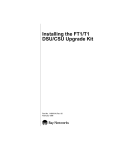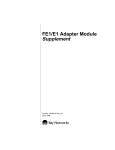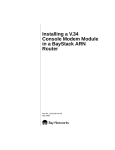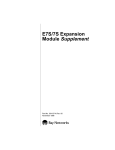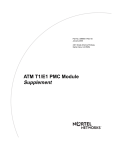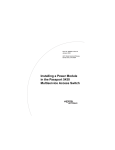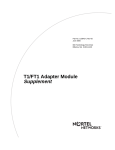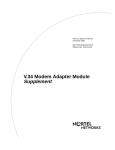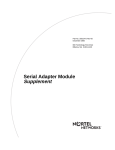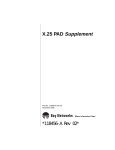Download Bay Networks Nautica 200 Installation guide
Transcript
Nautica 200 Installation Guide Part No. 117236-B Rev. 00 March 1998 4401 Great America Parkway Santa Clara, CA 95054 8 Federal Street Billerica, MA 01821 Copyright © 1998 Bay Networks, Inc. All rights reserved. Printed in the UK. March 1998. The information in this document is subject to change without notice. The statements, configurations, technical data, and recommendations in this document are believed to be accurate and reliable, but are presented without express or implied warranty. Users must take full responsibility for their applications of any products specified in this document. The information in this document is proprietary to Bay Networks, Inc. Trademarks Bay Networks and Nautica are registered trademarks and BCC and the Bay Networks logo are trademarks of Bay Networks, Inc. Microsoft, Windows, and Windows NT are registered trademarks of Microsoft Corporation. All other trademarks and registered trademarks are the property of their respective owners. Statement of Conditions In the interest of improving internal design, operational function, and/or reliability, Bay Networks, Inc. reserves the right to make changes to the products described in this document without notice. Bay Networks, Inc. does not assume any liability that may occur due to the use or application of the product(s) or circuit layout(s) described herein. ii 117236-B Rev. 00 USA Requirements Only Federal Communications Commission (FCC) Compliance Notice: Radio Frequency Notice This device complies with part 15 of the FCC Rules. Operation is subject to the following two conditions: • This device may not cause harmful interference. • This device must accept any interference received, including interference that may cause undesired operation. Note: This equipment has been tested and found to comply with the limits for a Class B digital device, pursuant to part 15 of the FCC Rules. These limits are designed to provide reasonable protection against harmful interference in a residential installation. This equipment generates, uses and can radiate radio frequency energy and, if not installed and used in accordance with the instructions, may cause harmful interference to radio communications. However, there is no guarantee that interference will not occur in a particular installation. If this equipment does cause harmful interference to radio or television reception, which can be determined by turning the equipment off and on, the user is encouraged to try to correct the interference by one or more of the following measures: • Reorient or relocate the receiving antenna. • Increase the separation between the equipment and receiver. • Connect the equipment into an outlet on a circuit different from that to which the receiver is connected. • Consult the dealer or an experienced radio/TV technician for help. European Requirements Only EN 55 022 Statement This is to certify that the Bay Networks Nautica 200 is shielded against the generation of radio interference in accordance with the application of Council Directive 89/336/EEC, Article 4a. Conformity is declared by the application of EN 55 022 Class B (CISPR 22). EC Declaration of Conformity This product conforms (or these products conform) to the provisions of Council Directive 89/336/EEC and 73/23/EEC. The Declaration of Conformity is available on the Bay Networks World Wide Web site at www.baynetworks.com. Power Supply The “in-wall” power module supplied with the Nautica 200 must be used to ensure continued compliance with the applicable regulations. Should a replacement power module be required, this must be obtained from Bay Networks. 117236-B Rev. 00 iii Port Specifications The Nautica 200 has five ports, which are classified as follows: 9V DC SELV PSU supply LAN SELV 10BASE-T LAN Manager SELV RS-232 serial port ISDN TNV ISDN line interface Telephone SELV Analog interfaces to telephony devices Interconnection circuits shall be selected to provide continued conformance with the requirements of EN60950:1992/A3:1995 clause 2.3 for SELV circuits and with the requirements of clause 6 for TNV circuits, after connections between equipments. Japan/Nippon Requirements Only Voluntary Control Council for Interference (VCCI) Statement Voluntary Control Council for Interference (VCCI) Statement This is a Class B product based on the standard of the Voluntary Control Council for Interference from Information Technology Equipment (VCCI). If this is used near a radio or television receiver in a domestic environment, it may cause radio interference. Install and use the equipment according to the instruction manual. iv 117236-B Rev. 00 Canada Requirements Only Canadian Department of Communications Radio Interference Regulations This digital apparatus ( ) does not exceed the Class B limits for radio-noise emissions from digital apparatus as set out in the Radio Interference Regulations of the Canadian Department of Communications. Règlement sur le brouillage radioélectrique du ministère des Communications Cet appareil numérique ( ) respecte les limites de bruits radioélectriques visant les appareils numériques de classe B prescrites dans le Règlement sur le brouillage radioélectrique du ministère des Communications du Canada. Canada CS-03 Rules and Regulations Note: The Canadian Department of Communications label identifies certified equipment. The certification means that the equipment meets certain telecommunications network protective, operational and safety requirements. The Department does not guarantee the equipment will operate to the user’s satisfaction. Before installing this equipment, users should ensure that it is permissible to be connected to the facilities of the local telecommunications company. The equipment must also be installed using an acceptable method of connection. In some cases, the company’s inside wiring associated with a single line individual service may be extended by means of a certified connector assembly (telephone extension cord). The customer should be aware that compliance with the above conditions may not prevent the degradation of service in some situations. Repairs to certified equipment should be made by a representative designated by the supplier. Any repairs or alterations made by the user to this equipment, or equipment malfunctions, may give the telecommunications company cause to request the user to disconnect the equipment. Users should ensure for their own protection that the electrical ground connections of the power utility, telephone lines and internal metallic water pipe system, if present, are connected together. This precaution may be particularly important in rural areas. Caution: Users should not attempt to make such connections themselves, but should contact the appropriate electric inspection authority, or electrician, as appropriate. Notice: For equipment using loopstart lines, please note that the Ringer Equivalence Number (REN) assigned to each terminal device provides an indication of the maximum number of terminals allowed to be connected to a telephone interface. The termination on an interface may consist of any combination of devices subject only to the requirement that the sum of the RENs of all the devices does not exceed 5.0. The REN is located on the “FCC Rules Part 68” label located on the bracket of the module, or on the back of the unit. Canada CS-03 -- Règles et règlements Note: L’étiquette du ministère des Communications du Canada indique que l’appareillage est certifié, c’est-à-dire qu’il respecte certaines exigences de sécurité et de fonctionnement visant les réseaux de télécommunications. Le ministère ne garantit pas que l’appareillage fonctionnera à la satisfaction de l’utilisateur. 117236-B Rev. 00 v Avant d’installer l’appareillage, s’assurer qu’il peut être branché aux installations du service de télécommunications local. L’appareillage doit aussi être raccordé selon des méthodes acceptées. Dans certains cas, le câblage interne du service de télécommunications utilisé pour une ligne individuelle peut être allongé au moyen d’un connecteur certifié (prolongateur téléphonique). Le client doit toutefois prendre note qu’une telle installation n’assure pas un service parfait en tout temps. Les réparations de l’appareillage certifié devraient être confiées à un service désigné par le fournisseur. En cas de réparation ou de modification effectuées par l’utilisateur ou de mauvais fonctionnement de l’appareillage, le service de télécommunications peut demander le débranchement de l’appareillage. Pour leur propre sécurité, les utilisateurs devraient s’assurer que les mises à la terre des lignes de distribution d’électricité, des lignes téléphoniques et de la tuyauterie métallique interne sont raccordées ensemble. Cette mesure de sécurité est particulièrement importante en milieu rural. Attention: Les utilisateurs ne doivent pas procéder à ces raccordements eux-mêmes mais doivent plutôt faire appel aux pouvoirs de réglementation en cause ou à un électricien, selon le cas. Avis: Veuillez prendre note que pour tout appareillage supportant des lignes de type “loopstart,” vous pouvez utiliser le Ringer Equivalence Number (REN) attribué à chaque terminal pour déterminer le nombre maximal de terminaux qui peuvent être branchés à votre interface de téléphones. Le raccordement à l’interface pourra se composer de toute combinaison de terminaux, pour autant que la somme des RENs ne dépasse pas cinq. Le REN figure sur l’étiquette “FCC Rules Part 68” située sur le support du module ou à l’arrière de l’unité. FCC Part 68 Compliance Statement This equipment complies with Part 68 of FCC Rules. All direct connections to telephone network lines must be made using standard plugs and jacks compliant with FCC Part 68. Please note the following: 1. You are required to request service from the telephone company before you connect the unit to a network. When you request service, you must provide the telephone company with the following data: • When you request T1 Service, you must provide the telephone company with -- The Facility Interface Code Provide the telephone company with all the codes below: - 04DU9-BN (1.544 MB, D4 framing format) 04DU9-DN (1.544 MB, D4 framing format with B8ZF coding) 04DU9-1KN (1.544 MB, ESF framing format) 04DU9-1SN (1.544 MB, ESF framing format with B8ZF coding) 04DU9-1ZN (1.544 MB, ANSI ESF and ZBTSI without line power) The telephone company will select the code it has available. vi -- The Service Order Code(s) (SOC): 6.0Y -- The required Universal Service Order Code (USOC) jack: RJ48C 117236-B Rev. 00 • • When you request ISDN “U” Interface Service, you must provide the telephone company with -- The Facility Interface Code: 02IS5 -- The Service Order Code(s) (SOC): 6.0F -- The required Universal Service Order Code (USOC) jack: RJ49C When you request ISDN “S/T” Interface Service, you must provide the telephone company with -- The Service Order Code(s) (SOC): 6.0P -- The make, model number, and FCC Registration number of the NT1 Note: ISDN S/T cannot be directly connected to the network. • When you request Primary Rate ISDN Service, you must provide the telephone company with -- The Facility Interface Code: 04DU9-1SN (1.544 MB, ESF framing format with B8ZF coding) -- The Service Order Code(s) (SOC): 6.0Y -- The required Universal Service Order Code (USOC) jack: RJ48C 2. Your telephone company may make changes to its facilities, equipment, operations, or procedures that could affect the proper functioning of your equipment. The telephone company will notify you in advance of such changes to give you an opportunity to maintain uninterrupted telephone service. 3. If the unit causes harm to the telephone network, the telephone company may temporarily discontinue your service. If possible, they will notify you in advance, but if advance notice is not practical, you will be notified as soon as possible and will be informed of your right to file a complaint with the FCC. 4. If you experience trouble with the unit, please contact the Bay Networks Technical Solutions Center in your area for service or repairs. Repairs should be performed only by service personnel authorized by Bay Networks, Inc. United States Valbonne, France Sydney, Australia Tokyo, Japan 5. 1-800-2LAN-WAN 33-4-92-96-69-68 61-2-9927-8800 81-3-5402-0180 You are required to notify the telephone company when you disconnect the unit from the network. 117236-B Rev. 00 vii Bay Networks, Inc. Software License Agreement NOTICE: Please carefully read this license agreement before copying or using the accompanying software or installing the hardware unit with pre-enabled software (each of which is referred to as “Software” in this Agreement). BY COPYING OR USING THE SOFTWARE, YOU ACCEPT ALL OF THE TERMS AND CONDITIONS OF THIS LICENSE AGREEMENT. THE TERMS EXPRESSED IN THIS AGREEMENT ARE THE ONLY TERMS UNDER WHICH BAY NETWORKS WILL PERMIT YOU TO USE THE SOFTWARE. If you do not accept these terms and conditions, return the product, unused and in the original shipping container, within 30 days of purchase to obtain a credit for the full purchase price 1. License Grant. Bay Networks, Inc. (“Bay Networks”) grants the end user of the Software (“Licensee”) a personal, nonexclusive, nontransferable license: a) to use the Software either on a single computer or, if applicable, on a single authorized device identified by host ID, for which it was originally acquired; b) to copy the Software solely for backup purposes in support of authorized use of the Software; and c) to use and copy the associated user manual solely in support of authorized use of the Software by Licensee. This license applies to the Software only and does not extend to Bay Networks Agent software or other Bay Networks software products. Bay Networks Agent software or other Bay Networks software products are licensed for use under the terms of the applicable Bay Networks, Inc. Software License Agreement that accompanies such software and upon payment by the end user of the applicable license fees for such software. 2. Restrictions on use; reservation of rights. The Software and user manuals are protected under copyright laws. Bay Networks and/or its licensors retain all title and ownership in both the Software and user manuals, including any revisions made by Bay Networks or its licensors. The copyright notice must be reproduced and included with any copy of any portion of the Software or user manuals. Licensee may not modify, translate, decompile, disassemble, use for any competitive analysis, reverse engineer, distribute, or create derivative works from the Software or user manuals or any copy, in whole or in part. Except as expressly provided in this Agreement, Licensee may not copy or transfer the Software or user manuals, in whole or in part. The Software and user manuals embody Bay Networks’ and its licensors’ confidential and proprietary intellectual property. Licensee shall not sublicense, assign, or otherwise disclose to any third party the Software, or any information about the operation, design, performance, or implementation of the Software and user manuals that is confidential to Bay Networks and its licensors; however, Licensee may grant permission to its consultants, subcontractors, and agents to use the Software at Licensee’s facility, provided they have agreed to use the Software only in accordance with the terms of this license. 3. Limited warranty. Bay Networks warrants each item of Software, as delivered by Bay Networks and properly installed and operated on Bay Networks hardware or other equipment it is originally licensed for, to function substantially as described in its accompanying user manual during its warranty period, which begins on the date Software is first shipped to Licensee. If any item of Software fails to so function during its warranty period, as the sole remedy Bay Networks will at its discretion provide a suitable fix, patch, or workaround for the problem that may be included in a future Software release. Bay Networks further warrants to Licensee that the media on which the Software is provided will be free from defects in materials and workmanship under normal use for a period of 90 viii 117236-B Rev. 00 days from the date Software is first shipped to Licensee. Bay Networks will replace defective media at no charge if it is returned to Bay Networks during the warranty period along with proof of the date of shipment. This warranty does not apply if the media has been damaged as a result of accident, misuse, or abuse. The Licensee assumes all responsibility for selection of the Software to achieve Licensee’s intended results and for the installation, use, and results obtained from the Software. Bay Networks does not warrant a) that the functions contained in the software will meet the Licensee’s requirements, b) that the Software will operate in the hardware or software combinations that the Licensee may select, c) that the operation of the Software will be uninterrupted or error free, or d) that all defects in the operation of the Software will be corrected. Bay Networks is not obligated to remedy any Software defect that cannot be reproduced with the latest Software release. These warranties do not apply to the Software if it has been (i) altered, except by Bay Networks or in accordance with its instructions; (ii) used in conjunction with another vendor’s product, resulting in the defect; or (iii) damaged by improper environment, abuse, misuse, accident, or negligence. THE FOREGOING WARRANTIES AND LIMITATIONS ARE EXCLUSIVE REMEDIES AND ARE IN LIEU OF ALL OTHER WARRANTIES EXPRESS OR IMPLIED, INCLUDING WITHOUT LIMITATION ANY WARRANTY OF MERCHANTABILITY OR FITNESS FOR A PARTICULAR PURPOSE. Licensee is responsible for the security of its own data and information and for maintaining adequate procedures apart from the Software to reconstruct lost or altered files, data, or programs. 4. Limitation of liability. IN NO EVENT WILL BAY NETWORKS OR ITS LICENSORS BE LIABLE FOR ANY COST OF SUBSTITUTE PROCUREMENT; SPECIAL, INDIRECT, INCIDENTAL, OR CONSEQUENTIAL DAMAGES; OR ANY DAMAGES RESULTING FROM INACCURATE OR LOST DATA OR LOSS OF USE OR PROFITS ARISING OUT OF OR IN CONNECTION WITH THE PERFORMANCE OF THE SOFTWARE, EVEN IF BAY NETWORKS HAS BEEN ADVISED OF THE POSSIBILITY OF SUCH DAMAGES. IN NO EVENT SHALL THE LIABILITY OF BAY NETWORKS RELATING TO THE SOFTWARE OR THIS AGREEMENT EXCEED THE PRICE PAID TO BAY NETWORKS FOR THE SOFTWARE LICENSE. 5. Government Licensees. This provision applies to all Software and documentation acquired directly or indirectly by or on behalf of the United States Government. The Software and documentation are commercial products, licensed on the open market at market prices, and were developed entirely at private expense and without the use of any U.S. Government funds. The license to the U.S. Government is granted only with restricted rights, and use, duplication, or disclosure by the U.S. Government is subject to the restrictions set forth in subparagraph (c)(1) of the Commercial Computer Software–– Restricted Rights clause of FAR 52.227-19 and the limitations set out in this license for civilian agencies, and subparagraph (c)(1)(ii) of the Rights in Technical Data and Computer Software clause of DFARS 252.227-7013, for agencies of the Department of Defense or their successors, whichever is applicable. 117236-B Rev. 00 ix 6. Use of Software in the European Community. This provision applies to all Software acquired for use within the European Community. If Licensee uses the Software within a country in the European Community, the Software Directive enacted by the Council of European Communities Directive dated 14 May, 1991, will apply to the examination of the Software to facilitate interoperability. Licensee agrees to notify Bay Networks of any such intended examination of the Software and may procure support and assistance from Bay Networks. 7. Term and termination. This license is effective until terminated; however, all of the restrictions with respect to Bay Networks’ copyright in the Software and user manuals will cease being effective at the date of expiration of the Bay Networks copyright; those restrictions relating to use and disclosure of Bay Networks’ confidential information shall continue in effect. Licensee may terminate this license at any time. The license will automatically terminate if Licensee fails to comply with any of the terms and conditions of the license. Upon termination for any reason, Licensee will immediately destroy or return to Bay Networks the Software, user manuals, and all copies. Bay Networks is not liable to Licensee for damages in any form solely by reason of the termination of this license. 8. Export and Re-export. Licensee agrees not to export, directly or indirectly, the Software or related technical data or information without first obtaining any required export licenses or other governmental approvals. Without limiting the foregoing, Licensee, on behalf of itself and its subsidiaries and affiliates, agrees that it will not, without first obtaining all export licenses and approvals required by the U.S. Government: (i) export, reexport, transfer, or divert any such Software or technical data, or any direct product thereof, to any country to which such exports or re-exports are restricted or embargoed under United States export control laws and regulations, or to any national or resident of such restricted or embargoed countries; or (ii) provide the Software or related technical data or information to any military end user or for any military end use, including the design, development, or production of any chemical, nuclear, or biological weapons. 9. General. If any provision of this Agreement is held to be invalid or unenforceable by a court of competent jurisdiction, the remainder of the provisions of this Agreement shall remain in full force and effect. This Agreement will be governed by the laws of the state of California. Should you have any questions concerning this Agreement, contact Bay Networks, Inc., 4401 Great America Parkway, P.O. Box 58185, Santa Clara, California 95054-8185. LICENSEE ACKNOWLEDGES THAT LICENSEE HAS READ THIS AGREEMENT, UNDERSTANDS IT, AND AGREES TO BE BOUND BY ITS TERMS AND CONDITIONS. LICENSEE FURTHER AGREES THAT THIS AGREEMENT IS THE ENTIRE AND EXCLUSIVE AGREEMENT BETWEEN BAY NETWORKS AND LICENSEE, WHICH SUPERSEDES ALL PRIOR ORAL AND WRITTEN AGREEMENTS AND COMMUNICATIONS BETWEEN THE PARTIES PERTAINING TO THE SUBJECT MATTER OF THIS AGREEMENT. NO DIFFERENT OR ADDITIONAL TERMS WILL BE ENFORCEABLE AGAINST BAY NETWORKS UNLESS BAY NETWORKS GIVES ITS EXPRESS WRITTEN CONSENT, INCLUDING AN EXPRESS WAIVER OF THE TERMS OF THIS AGREEMENT. x 117236-B Rev. 00 Nautica 200 Installation Guide The Nautica® 200 is a high performance Internet Protocol (IP) router that provides connectivity over the Integrated Services Digital Network (ISDN) for telecommuters and the small office, home office (SOHO) workers. This guide describes the physical installation of the Nautica 200. For basic configuration of the Nautica 200, start the Installation Assistant by loading the setup software on the accompanying CD (see page 8). Nautica Wizard, a Microsoft Windows® 95/ Windows NT® application, is used to perform configuration tasks. Experienced network users can troubleshoot the Nautica 200 using a command line interface, which is available via Telnet or HyperTerminal (see step 5 on page 7). This guide contains the following sections: 117236-B Rev. 00 • "Checklist" (page 2) • "Site Preparation" (page 3) • "ISDN Ordering Information" (page 4) • "Hardware Installation" (page 5) • "Minimum Requirements" (page 8) • "Software Installation" (page 8) • "Additional Information" (page 9) 1 Nautica 200 Installation Guide Checklist Before you begin the installation, ensure that you have received everything you need. If any items are missing, please contact the supplier of your Nautica 200. Make sure that your Nautica 200 package includes the following items: 2 • The Nautica 200 router • One power supply unit (PSU) of the correct voltage rating (See Table 1) • One ISDN cable (black) labelled 119071-A, or one ISDN cable (red) labelled 117238 • One Installation CD • One Manager cable labelled 117239 • One Ethernet Local Area Network (LAN) cable (gray) labelled 118314 • One RJ-45 to RJ-11 ISDN cable labelled 119068-A (U.S. only) • Two British Telecom (BT) telephone adapters (UK only) 117236-B Rev. 00 Nautica 200 Installation Guide Site Preparation You should install the Nautica 200 on a flat surface, in a clean, dry location with no extreme temperatures. Make sure that all of the required services (power, LAN access, ISDN and any telephones, facsimiles and modems) are available and working correctly. Make sure that there is sufficient space on all sides of the Nautica 200 to ensure that it does not exceed the maximum temperature (Table 1). Table 1 lists the operating requirements for correct installation of the Nautica 200. Table 1. Operating Requirements Parameter Specification Power supply: Europe 220 to 240 VAC, 50 Hz (nominal) Power supply: North America 110 VAC, 60 Hz Power supply current 41 mA @ 240 VAC 90 mA @ 110 VAC Power consumption 10 W (nominal) Operating temperature 10o to 40oC (50o to 104oF) Humidity 5% to 95% (nonconducting) LAN cable (maximum length) 100 m Cat 3 or 5 Telephone ports (two) You can connect a facsimile, telephone or modem to these ports.(Not Australian Version) Note: Before you begin the installation, make sure you have everything you need. See "Checklist" on page 2. 117236-B Rev. 00 3 Nautica 200 Installation Guide ISDN Ordering Information Use of an ISDN router over a public ISDN network is usually on a pay-as-you-go basis. You pay for the time that your ISDN link is connected, although some suppliers also charge for every call attempt. Your ISDN router makes calls when there is one or more packets to send to a remote network. In order to reduce the number of ISDN calls this can generate, it is important that you read the “Additional Information” section (page 9). The options outlined here can dramatically reduce the number of automatic ISDN calls made by your router. Your Nautica router comes with a software package called Nautica Watch. Nautica Watch allows you to monitor the activity on your router. The green LED will flash continuously when the router is in use. If this happens when you are not actively using your PC, then the PC or an application on the PC is connecting to a remote network resource. If you are in any doubt at all about any of the following points or the operation of your router, contact your local ISDN supplier for advice. The remainder of this section describes the ordering information you need if you plan to use ISDN to connect your Nautica 200 to other devices. European ISDN Information If you require ISDN in Europe, do the following: 4 • If you require calling line identification (CLI) for additional security, order the CLI option from your ISDN provider. • If possible, order both B channels with the same ISDN number. This is known as auxiliary working and can speed up connection times, particularly if you are using both ISDN channels. 117236-B Rev. 00 Nautica 200 Installation Guide North American ISDN Information If you require ISDN in North America, do the following: • Ensure that you know whether the ISDN line is configured in standard national ISDN mode or in the manufacturer’s custom mode. • Find out if your ISDN interface is point-to-point or multipoint. • Ensure that you have the same switch type configured as your ISDN provider’s central office. If you are unsure of the switch type, check with your ISDN service provider. • Ensure that you have the local directory numbers assigned to the line by your ISDN service provider. • Ensure that you have the Service Profile Identifiers (SPIDs) for the local directory numbers, also assigned by your ISDN service provider. Hardware Installation This section describes the physical installation of the Nautica 200. For safety, follow all of the steps in the order presented. Connecting the Cables The Nautica 200 package includes all of the required cables. For a list of the cables, see "Checklist" on page 2. Figure 1 and Figure 2 show the ports on the back of the Nautica 200 and the recommended installation procedure. A description of each numbered item in the figure follows. 117236-B Rev. 00 5 Nautica 200 Installation Guide 6 Figure 1. Nautica 200 Cabling Options (All countries except Australia) Figure 2. Nautica 200 Cabling Options (Australia) 117236-B Rev. 00 Nautica 200 Installation Guide 1. Connect one end of the black ISDN cable (labelled 119071-A) or the red ISDN cable (labelled 117238) to the ISDN port on the back of the Nautica 200. Then, connect the other end of the cable to the ISDN wall outlet. In North America, instead of the ISDN cables mentioned in point one, you may have an RJ-45 to RJ-11 cable (labelled 119068-A) instead. Connect the RJ-45 end of this cable into the back of the Nautica 200 and the RJ-11 end of the same cable into the ISDN wall outlet. 2. Connect one end of the gray LAN cable (labelled 118314) to the LAN port. Then, connect the other end of the cable to the NIC on the back of your PC. Note: If you are iunstalling the Australian version (see Figure 2), ignore step 3 and proceed to step 4. 3. Connect one telephony device (telephone, facsimile or modem) to each telephone port. If you are in the UK, you must use the telephone adapters supplied with your Nautica 200. In other countries, you may need to supply your own telephone adapters. 4. Connect the power cable to the port labelled 9v DC. The Nautica 200 has no on/off switch; it turns on immediately when you plug the power adapter into the power outlet. Warning: Disconnect the ISDN cable from the wall outlet before connecting it to or disconnecting it from the Nautica 200. 5. 117236-B Rev. 00 The Manager port is used for troubleshooting only. The Manager cable is labelled 117239. Connect this cable only if you are an experienced user of Nautica products and you want to start a local management session with the Bay Command Console (BCC™). 7 Nautica 200 Installation Guide Minimum Requirements Before installing Nautica Wizard, ensure that your PC meets the following minimum requirements: • 486 33 Mhz or higher IBM-compatible PC running Microsoft Windows 95 or Windows NT 4.0. • 2X CD-ROM drive (if installing software from the supplied CD). • 256-color VGA display (640x480). An SVGA display (800x600) is required for advanced options. Software Installation Once the cables are connected and the Nautica 200 has powered up, load the Nautica 200 configuration software onto your PC. 8 1. Insert the CD that came with the Nautica 200 package into your CD-ROM drive. 2. If auto-start is enabled on your PC, the setup program starts automatically. 3. If the setup program does not start automatically, launch Windows Explorer, change to the CD-ROM drive, then double-click on the program icon called setup.exe. 4. First time users should agree to place the icons for Nautica Wizard and Nautica Watch on the desktop for easy access in the future. 5. The software is loaded onto your PC and the Installation Assistant starts, allowing you to configure the Nautica 200. 117236-B Rev. 00 Nautica 200 Installation Guide 6. If the Installation Assistant does not start automatically, double-click on the Nautica Wizard icon, click on the Nautica 200 icon in the Nautica Wizard window, then click on the Configure button at the bottom of the Nautica Wizard window. Note: The Nautica Configuration Wizard CD auto-run feature causes the installation software to run every time the CD is inserted. If you do not want to re-install the software, cancel out of the installation process once it is initialized. For more information about Nautica Wizard and the Installation Assistant, see the online Help in the programs and the online documentation (Nautica Wizard Configuration Reference Guide) on the CD that came with your Nautica 200 package. Note: If you intend to use Network Address Translation (NAT), in the Installation Assistant, select the standard routing option, give the unit an IP address and then click on the Finish button. Next, click on Advanced > NAT and set up the NAT information. For more details on NAT, refer to the online documentation on the CD. Additional Information The information outlined in this section highlights operational features that you need to be aware of before using the Nautica 200. Setting up e-mail Most TCP/IP based e-mail clients can be configured to check the mail server for new mail at set intervals. This is known as polling. 117236-B Rev. 00 9 Nautica 200 Installation Guide If your computer is locally attached to a mail server, it may be appropriate to poll for e-mail every five minutes or less. These rules change if your computer is remotely connected to a mail server via an ISDN router. It is not appropriate, for example, to have the router calling the remote mail server every five minutes to check for new mail. To this end, it is recommended that you configure your e-mail client for manual polling (where you press a button to check for e-mail), or for a longer polling interval, such as once every hour. Be aware though, that even with an hourly polling setting, the router will make one call every hour. If you leave your PC and router running overnight, this would mean 24 calls every day, even if you have no new e-mail. Remotely Mapped Drives In most popular PC operating systems, it is possible to map virtual drives (such as J:) to file servers on the network. If you map network drives over a remote ISDN connection, problems can occur. Every time you open a file, or move into a new folder, it is likely that the PC may request the current status of all drives and bring up an ISDN call to achieve this. For this reason, it is recommended that you do not permanently map network drives over a remote ISDN connection. Similarly, if you browse the network over a remote ISDN connection you will incur ISDN call charges. File and Print Sharing Many workgroup functions, designed to allow resource sharing on a local network, use a periodic announcement/update mechanism which causes frequent ISDN calls if used over a remote ISDN connection. In order to avoid this, it is recommended that you turn off file and print sharing on your PC. 10 117236-B Rev. 00 Nautica 200 Installation Guide To achieve this, do the following: 1. Click on the Start Button. 2. Choose Settings > Control Panel. 3. Double click on the Networks icon. 4. Click on the File and Print Sharing button. 5. Deselect both options in the File and Print Sharing window: Figure 1. File and Print Sharing Window 6. Click on OK in the File and Print Sharing window. 7. Click on OK in the Networks window. 8. Close the Control Panel. 9. It may be necessary to reboot your PC at this time. Graphical FTP Using “Keep Alive” Traditionally FTP servers time out (or end) an FTP session if there is no activity after a few minutes. Most command line FTP clients take no steps to avoid this timeout. Some of the new graphical FTP clients, however, make frequent read (or keepalive) requests to keep the FTP sessions alive. This option is fine for local network access and leased line Internet browsing, but it can cause your remote ISDN connection to stay up permanently. 117236-B Rev. 00 11 Nautica 200 Installation Guide If you use such FTP clients, be aware of this problem and close down remote FTP connections once you have finished transferring files. Web Browsers When you are browsing the Web, many sites use “push” technology. This feature opens a permanent channel between the Web site and your PC in order to update sound and graphic files continuously. Using a remote router, such sites will keep your ISDN connection open. Other Web sites cause your browser to refresh the screen at regular intervals, for example, every 30 seconds. Again, this can cause a link to stay open. In order to minimize the effect of these data streams, do not leave your PC unattended when you have a Web site oen and close down all Internet connections when you have finished with them. When browsing the Web, be aware that ISDN calls are being made. 12 117236-B Rev. 00






















